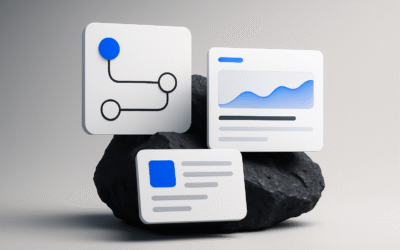Unlocking Success: The Role of Data Analytics in Digital Marketing
Hey there! Ever feel like you’re throwing your marketing efforts into the void, hoping something sticks? Maybe you’ve launched a beautiful social campaign that barely got any traction or spent months on an email sequence that’s not converting. We’ve all been there, and that uncertainty can be frustrating. But here’s the good news: with the right analytics approach, you can turn that uncertainty into a rock-solid strategy. And don’t worry – we’re not here to drown you in complex charts and confusing metrics. Instead, let’s chat about how analytics can be your secret weapon for marketing success.
Think of analytics as your marketing GPS. Sure, you might know where you want to go (more sales, better engagement, stronger brand awareness), but wouldn’t it be great to know exactly how to get there? That’s what we’re diving into today – and trust us, it’s going to be a game-changer for your business.
Getting Cozy with Analytics Basics
Let’s start with the good stuff – understanding what analytics can actually do for you. You know how a good friend gives you honest feedback? That’s analytics in a nutshell. When we talk about analytics in marketing, we’re really talking about four different ways to look at your data, each one giving you a unique perspective on your marketing efforts.
First up is descriptive analytics, which tells you exactly what happened in your campaigns. Imagine you’ve just run a holiday promotion. Descriptive analytics would show you that you reached 50,000 people, got 2,500 clicks to your website, and made 150 sales. It’s like having a replay of your favorite sports game – you can see every play that worked and every one that didn’t.
Then there’s diagnostic analytics, which helps you understand why things happened the way they did. Let’s say those 150 sales mostly came from email marketing, not your social media ads. Diagnostic analytics would help you discover that your email subject lines were particularly compelling, or that your social media timing was off. It’s your “aha!” moment maker, connecting those dots between your actions and their results.
But here’s where it gets really exciting: predictive analytics. This is where we get to play fortune teller (but with actual data backing us up). By looking at patterns in your past performance, we can make educated guesses about what might happen next. For instance, if you notice your engagement rates spike every Wednesday morning, you can plan your most important content for those peak times. And finally, there’s prescriptive analytics – think of it as your strategic advisor, helping you figure out exactly what to do with all these insights.
Building Your Data-Driven Marketing Strategy
Now, let’s talk about putting all this knowledge to work. You wouldn’t build a house without a blueprint, right? The same goes for your marketing strategy. Instead of tracking every possible metric, let’s focus on what really matters for your business.
Start by asking yourself what success looks like for your brand. For an e-commerce business, success might mean increasing average order value from $50 to $75. For a B2B company, it might be generating 25% more qualified leads each quarter. Once you know what you’re aiming for, we can set up the right measurement framework to track your progress.
Let’s say you’re running a small fashion boutique online. Your measurement framework might look like this: tracking new vs. returning customers, average order value, most popular products by season, and customer acquisition cost by marketing channel. This is like having a fitness tracker for your marketing efforts – you’ll know exactly how well you’re doing and what needs a little extra attention.
The real magic happens when you start connecting data across different channels. Imagine discovering that customers who first discover you through Instagram, then sign up for your email list, typically make their first purchase within two weeks – but only if they’ve received at least three emails from you. That’s the kind of insight that can transform your marketing from good to extraordinary.
Turning Data into Gold
Here’s where things get really fun. Having data is great, but knowing what to do with it? That’s where the magic happens. Let’s say you’re a local gym owner. Your analytics might show that your blog post about “5-minute morning workouts” is getting three times more traffic than any other content. That’s not just a random stat – it’s telling you something valuable about what your audience wants. You could expand this into a series of quick workout guides, create a morning workout challenge, or even develop a mini-course around the concept.
Or perhaps you’re running a SaaS company, and your analytics show that users who complete your product tutorial within the first 24 hours are 80% more likely to become long-term customers. That’s your cue to improve your onboarding process and maybe even offer incentives for completing the tutorial quickly.
The Future is Bright (and Data-Driven)
Looking ahead, the world of marketing analytics is getting even more exciting. Imagine AI tools that can automatically spot trending topics in your industry before they peak, or machine learning algorithms that can predict which customers are most likely to become brand advocates. These aren’t just fancy features – they’re practical tools that can help you make better decisions faster.
Privacy is also becoming increasingly important in the analytics world. With the phase-out of third-party cookies and stricter privacy regulations, we’re seeing a shift toward first-party data collection. This means building direct relationships with your audience through things like loyalty programs, email subscriptions, and community building. It’s not just about following regulations – it’s about creating better, more meaningful connections with your customers.
Making It All Work Together
The best part about modern analytics? You don’t have to piece together a dozen different tools to get the insights you need. Let’s look at a real-world example: Say you’re running a small digital agency. Your analytics stack might include Google Analytics 4 for website tracking, a social media management tool like Hootsuite or Buffer with built-in analytics, and your email platform’s native analytics.
Here’s how this could work in practice: You notice through GA4 that a significant portion of your website traffic comes from LinkedIn. Your social media analytics show that your how-to posts about marketing automation get the most engagement. Meanwhile, your email analytics reveal that subscribers who came from LinkedIn have a 40% higher open rate than other sources. Connecting these dots, you might decide to create an email course about marketing automation, promote it heavily on LinkedIn, and use that to grow your email list with highly engaged subscribers.
The key is starting with one core tool and gradually adding others as you need them. Think of it like building a house – you need a solid foundation before adding all the fancy fixtures.
From Data to Action: Real-World Applications
Let’s get super practical here. Imagine you’re reviewing your analytics and discover these insights:
Your website analytics show that mobile visitors spend 50% less time on your site than desktop users. Instead of just noting this difference, you can take immediate action: optimize your mobile site speed, adjust your content layout for mobile screens, and maybe even create mobile-specific offers.
Or perhaps your email analytics reveal that subscribers who read your case studies are three times more likely to request a consultation. This insight could reshape your entire content strategy – leading you to create more case studies and feature them prominently in your welcome email sequence.
Making Analytics Work for Your Business Size
Whether you’re a solopreneur or running a growing business, analytics can scale with you. For solopreneurs, start by focusing on just a few key metrics that directly tie to revenue. Maybe that’s tracking your top three traffic sources and conversion rates from each. As you grow, you can expand to more sophisticated tracking like customer lifetime value and attribution modeling.
Here’s what this might look like for different business sizes:
For solopreneurs: Focus on basic website analytics, email open rates, and social media engagement. Use these insights to optimize your most important marketing channel – whether that’s your blog, YouTube channel, or Instagram account.
For small businesses: Add customer journey tracking, basic conversion analysis, and ROI measurements for different marketing channels. This helps you make informed decisions about where to invest your growing marketing budget.
For growing companies: Implement more sophisticated tools for customer segmentation, predictive analytics, and multi-channel attribution. These insights can help you scale what’s working and identify new opportunities for growth.
Your Next Steps: A 30-Day Plan
Let’s wrap this up with an actionable plan you can start implementing today:
Week 1: Audit your current analytics setup. What are you already tracking? What insights are you missing? Make sure your basic tracking is properly installed and collecting accurate data.
Week 2: Define your key performance indicators (KPIs). Don’t try to track everything – focus on metrics that directly impact your business goals. If you’re an e-commerce business, this might be average order value, cart abandonment rate, and customer acquisition cost.
Week 3: Start looking for patterns in your data. Spend 30 minutes each morning reviewing your analytics. Look for unexpected trends, surprising customer behaviors, or opportunities you might have missed.
Week 4: Begin testing and optimizing based on your findings. Maybe you’ll adjust your email sending times, try new content formats, or experiment with different call-to-action placements.
The Power Is in Your Hands
Remember, analytics isn’t about drowning in data – it’s about making smarter decisions for your business. Start small, focus on metrics that matter, and gradually build your analytics muscle. Soon enough, you’ll be making data-driven decisions that drive real results.
And hey, if you’re ever feeling stuck or overwhelmed, we’re here to help. At Everzocial, we believe every business can harness the power of analytics to grow and thrive. Sometimes you just need a friendly guide to show you the way.
Ready to transform your marketing with the power of analytics? Let’s make it happen! Drop us a comment below or reach out if you have questions – we’d love to hear about your analytics journey. 🚀








0 Comments